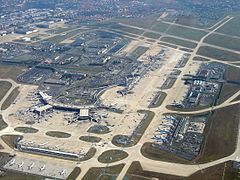Port lotniczy Paryż-Orly
 Widok z lotu ptaka na terminale (2007) | |||||||
| Państwo | |||||||
|---|---|---|---|---|---|---|---|
| Miejscowość | |||||||
| Właściciel | |||||||
| Kod IATA | ORY | ||||||
| Kod ICAO | LFPO | ||||||
| Strefa czasowa | UTC +1 | ||||||
| Wysokość | 89 m n.p.m. | ||||||
| Statystyki ruchu (2019[1]) | |||||||
| Liczba pasażerów | 31 853 049 | ||||||
| Cargo | 88 609 t | ||||||
| Liczba operacji | 218 349 | ||||||
| Drogi startowe | |||||||
| |||||||
| Strona internetowa | |||||||
Port lotniczy Paryż-Orly (fr. Aéroport d'Orly) – francuski międzynarodowy port lotniczy, położony 13 kilometrów na południe od centrum Paryża. Jedno z dwóch dużych lotnisk obsługujących francuską aglomerację stołeczną (drugie to Charles de Gaulle). Port w Orly obsługuje głównie połączenia w Europie, w Afryce, na Bliskim Wschodzie oraz na Karaibach.
Port lotniczy w Orly posiada dwa terminale pasażerskie: zachodni Orly Ouest oraz południowy Orly Sud. W marcu 2019 roku zmieniono nazwę terminali o budynek przyłącza. Orly Ouest dzieli się na Orly 1 i Orly 2, nowy budynek węzła przyjmuje nazwę Orly 3, a Orly Sud staje się Orly 4.
Port jest położony niedaleko autostrady. Posiada też połączenia autobusowe RATP oraz kolejowe RER.
W 2002 lotnisko obsłużyło ponad 23 mln pasażerów, czyli 1/3 korzystających z paryskich portów lotniczych. Z tego blisko dwie trzecie (15 mln) skorzystały z terminalu zachodniego, pozostałych 8 milionów – z południowego. Orly może w ciągu roku obsłużyć do 30 mln podróżnych.
Utrzymaniem lotniska zajmuje się spółka Aéroports de Paris.
Historia
W 1975 doszło do dwóch nieudanych zamachów terrorystycznych. Kilku terrorystów, wśród nich Carlos (Szakal), próbowało zniszczyć samoloty izraelskich linii lotniczych El Al.
Statystyki
Zobacz zapytanie i odniesienia źródłowe Wikidata o wartości.
Linie lotnicze i połączenia
Przypisy
- ↑ Zarchiwizowana kopia. [dostęp 2011-06-07]. [zarchiwizowane z tego adresu (2010-11-30)].
- ↑ a b LEVEL reveals location of second European base :: Routesonline, routesonline.com [dostęp 2018-07-23] (ang.).
Media użyte na tej stronie
Autor: Superbenjamin, Licencja: CC BY-SA 4.0
Blank administrative map of France for geo-location purpose, with regions and departements distinguished. Approximate scale : 1:3,000,000
Symbol lotniska do legendy mapy
The national and official state flag of Haiti; arms obtained from http://www.webchantier.com/. The civil flag can be found at here.
The flag of the Dominican Republic has a centered white cross that extends to the edges. This emblem is similar to the flag design and shows a bible, a cross of gold and 6 Dominican flags. There are branches of olive and palm around the shield and above on the ribbon is the motto "Dios,Patria!, Libertad" ("God, Country, Freedom") and to amiable freedom. The blue is said to stand for liberty, red for the fire and blood of the independence struggle and the white cross symbolized that God has not forgotten his people. "Republica Dominicana". The Dominican flag was designed by Juan Pablo Duarte, father of the national Independence of Dominican Republic. The first dominican flag was sewn by a young lady named Concepción Bona, who lived across the street of El Baluarte, monument where the patriots gathered to fight for the independence, the night of February 27th, 1844. Concepción Bona was helped by her first cousin María de Jesús Pina.
Autor: Pedro A. Gracia Fajardo, escudo de Manual de Imagen Institucional de la Administración General del Estado, Licencja: CC0
Flaga Hiszpanii
The flag of Navassa Island is simply the United States flag. It does not have a "local" flag or "unofficial" flag; it is an uninhabited island. The version with a profile view was based on Flags of the World and as a fictional design has no status warranting a place on any Wiki. It was made up by a random person with no connection to the island, it has never flown on the island, and it has never received any sort of recognition or validation by any authority. The person quoted on that page has no authority to bestow a flag, "unofficial" or otherwise, on the island.
Flag of Senegal
Flag of the Ivory Coast, written by Jon Harald Søby, modified by Zscout370. The colors match to what is reported at http://fotw.vexillum.com/flags/ci.html.
Flag of Portugal, created by Columbano Bordalo Pinheiro (1857-1929), officially adopted by Portuguese government in June 30th 1911 (in use since about November 1910). Color shades matching the RGB values officially reccomended here. (PMS values should be used for direct ink or textile; CMYK for 4-color offset printing on paper; this is an image for screen display, RGB should be used.)
Łatwo można dodać ramkę naokoło tej grafiki
Flaga Finlandii
Flag of Israel. Shows a Magen David (“Shield of David”) between two stripes. The Shield of David is a traditional Jewish symbol. The stripes symbolize a Jewish prayer shawl (tallit).
Flag of Albania
Autor: Muhammad ECTOR Prasetyo, Licencja: CC BY 2.0
Paris-Orly Airport














































